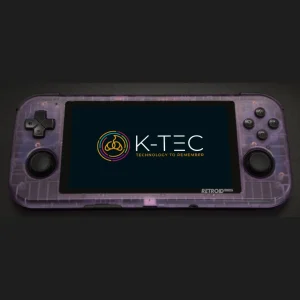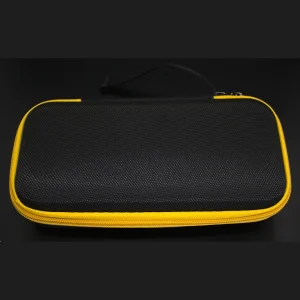What can you expect from your Retroid Pocket 3+
These handhelds use software emulation in order to be able to play games from so many different consoles. This means that there may sometimes be some minor differences with the way games played on the original console. However, it also mean that you can play thousands of games, from many dozens of console/handheld/home computer, all on the same device. It also means that some enhancements can be enabled. For instance, we’ve enabled PGXP Geometry Correction (to fix the wobbly textures) and triple-resolution for the Sony PlayStation.
With some games, you will notice significant stutters on title/loading screens, menus and cinematics. Once you get into the game-play itself, this will no longer be an issue. For some consoles, you may see shader-compilation stuttering during game-play, but this will clear up as you progress through the level. Title/loading screen stutters are particularly noticeable with Nintendo 3DS games, sometimes lasting tens of seconds, but will improve on a second play-through; again, game-play itself does not suffer from this.
Some games will ask you whether you want to use 50Hz or 60Hz. These will be from the higher-end consoles, and we recommend that you choose 50Hz. Running at 50Hz (PAL) is less demanding and there will be fewer stutters.
Higher-end consoles, such as the 3DS, GameCube, and PS2 push the capabilities of this handheld. In order to play your favourite games from these systems, with decent performance, some compromises are made. For instance, God of War and God of War II (PS2) are quite playable on this device. However, to get that performance our configuration enables some settings that result in a frame-rate that is not as smooth as the original.
K-TEC Enhancements
Buy from K-TEC
If your handheld didn’t come with these enhancements, buy from K-TEC in future.
microSD cards
We ship these devices with brand-name microSD cards.
We are so confident about the quality of these cards that we provide a lifetime guarantee.
It’s important to make a backup
Even with the lifetime guarantee we give our microSD cards, it is still recommended that you backup your card(s) as soon as you receive your device. See How to backup your retro handheld’s microSD card(s)
Android
Daijishou
Daijishou is one of the most popular Android retro-gaming frontends, at the moment. We have installed and fully configured this app for you.
Auto-save/load
Many of the consoles support the creation of auto-save-states when you quit, and auto-loading of those save-states when you next start the game. When playing a game from a supported console, quit the game with L3(press the left joystick like a button) + START when you’re in the middle of playing, and the game will automatically start from that point the next time you play.
Performance modes
If you swipe down from the top of the screen (twice), you’ll see a button to select between different performance modes:
- Balance
- Performance
- Extreme
The Balance mode can handle most 2D games and and will offer the best battery life. You’ll want to use Extreme mode for the higher-powered consoles mentioned previously, but you’ll sacrifice battery life. Performance mode should be able to handle up to DreamCast and PSP and offers a good compromise between performance and battery life.
K-TEC Configuration
Our guiding principle is that every device we sell should live up to its full potential, right out of the box – see “Why I started K-TEC”.
To that end, we have spent many hours tweaking settings, testing, re-tweaking, re-testing, and so on, until we’re satisfied that we can’t get any more out of the Retroid Pocket 3 Plus. The fruits of our labour include:
55 consoles
A Pocket 3 Plus straight from Retroid has only 12 consoles enabled. We fully configure 55 consoles, ready to play right out of the box.
(even more) Performance
Without our configuration, some games on the GameCube stutter frustratingly. With our meticulously-optimized configuration, performance is so good that we forget we’re supposed to be be testing the games and start playing them.
Enhancements
Where performance allows, we’ve enabled enhancements in the emulators. For instance, we’ve enabled triple-resolution for the PSP and PS1.
Console-like experience
When you finish playing a game, press the HOME button twice to get back to the front-end. Choose a different game and launch it. It doesn’t matter whether it’s using the same emulator, or a different one, it just works. This has involved the process of getting many emulators to play nicely with each other.
Wii control schemes
The Retroid Pocket 3 Plus is powerful enough to play some Wii games. The Wii demonstrated incredible innovation when it came to control schemes, many of which we take into account. See the usage tips for more detail.
Vertical arcade games
Some Arcade games were designed to be played on a vertical screen. With our configuration, these display vertically and use the controls that will then be on the bottom as you’re holding it.
Dual-screen handhelds
For the Nintendo DS and 3DS, we’ve mapped consistent controls for changing the layout:
- Select layout: L3 (click the left joystick)
- Swap screens: R3 (click the right joystick)
ZX Spectrum controls
We’ve configured the games to map the RP3+’s inputs to their desired control schemes.
For instance, Skool Daze is a game that uses keyboard input. Fire it up and it works straight away with the Retroid Pocket 3 Plus’s buttons.
With RoboCop, choose Kempston when asked and the device’s buttons will work perfectly. See the usage tips below for more detail.
Tips for using the Retroid Pocket 3 Plus
Android
The Retroid Pocket 3 Plus is an Android device. Power and sleep work the same as on your phone. Functions such as activating Wi-Fi should also be familiar.
Traversing between consoles, etc.
Use L2/R2 or swipe left and right.
Traversing game lists
Use R2/L2 to jump the next/previous letter.
Quitting a game
Press the HOME button twice.
ARCADE/CPS/Neo Geo
To “insert coins”, press SELECT.
Famicom Disk System
To PLEASE SET DISK B, use following input sequence:
- L1
- L2
- L1
Wii
Different games will want to use different control schemes. We’ve set up input profiles for control schemes that make sense on this device. To choose one:
- Press the BACK button to bring up the menu
- Tap Settings
- Tap Wii Input
- Tap the cog symbol for Wii Remote 1
- Tap Profiles
- Swipe up to expand the drawer from the bottom of the screen
- Tap the icon with the up-arrow for the profile you want to use.
- Tap Yes
- Press the BACK button a few times to get back to the game.
Nintendo DS/3DS
Use L3 (click the left joystick) to cycle between layouts.
Use R3 (click the right joystick) to swap between screens.
Nintendo 3DS
Your Retroid Pocket 3 Plus is powerful enough to play some 3DS games at double the native resolution, but some it can only handle at 1x the native resolution. We have set the default as 1x native resolution. If you’d like to see whether your favourite 3DS game will play at double resolution, please follow these instructions:
- Press the BACK button to bring up the menu
- Tap Settings
- Tap Graphics
- Tap Internal Resolution
- Adjust the slider until it reads 2x
- Tap OK
- Press the BACK button a few times to get back to the game
Don’t forget to set this back to 1x for games that require it.
Home Computers
Such as the Amstrad CPC, Commodore 64, or ZX Spectrum.
On-screen keyboard
Sometimes they will ask you to press a key on the keyboard. On the Amstrad CPC, press SELECT+START to bring up the on-screen-keyboard; for the rest, press SELECT.
Input method
If asked, prefer Kempston for ZX Spectrum, or Joystick for the other Home Computers.

